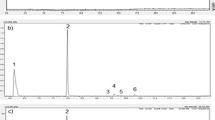Abstract
A volatile kairomone emitted from lima bean plants (Phaseolus lunatus) infested with the spider miteTetranychus urticae, was collected on Tenax-TA and analyzed with GC-MS. Two components were identified as the methylene monoterpene (3E)-4,8-dimethyl-1,3,7-nonatriene and the methylene sesquiterpene (3E,7E)-4,8,12-dimethyl-1,3,7,11-tridecatetraene, respectively, after purification by preparative GC on a megabore column and recording of UV, IR, and [1H]NMR spectra. The response of two species of predatory mites towards the identified chemicals was tested in a Y-tube olfactometer. Four of the compounds tested, linalool (3,7-dimethyl-1,6-octadien-3-ol), (E)-β-ocimene [(3E)-3,7-dimethyl-1,3,6-octatriene], (3E)-4,8-dimethyI-1,3,7-nonatriene, and methyl salicylate attracted females ofPhytoseiulus persimilis. Linalool and methyl salicylate attracted females ofAmblyseius potentillae. The response ofA. potentillae to these two kairomone components was affected by the rearing diet of the predators in the same way as was reported for the response to the natural kairomone blend: when reared on a carotenoid-deficient diet, the predators responded to the volatile kairomone ofT. urticae, but when reared on a carotenoid-containing diet they did not. The identified kairomone components are all known from the plant kingdom. They are not known to be produced by animals de novo. In addition to biological evidence, this chemical evidence suggests that the plant is involved in production of the kairomone. Based on the present study and literature data on the response ofT. urticae to infochemicals, it is concluded that the kairomone component linalool is also a component of a volatile spider-mite dispersing pheromone.
Similar content being viewed by others
References
Dabrowski, Z.T., andRodriguez, J.G. 1971. Studies on resistance of strawberries to mites. 3. Preference and nonpreference responses ofTetranychus urticae andT. turkestani to essential oils of foliage.J. Econ. Entomol. 64:387–391.
Dicke, M. 1986. Volatile spider-mite pheromone and host-plant kairomone, involved in spacedout gregariousness in the spider miteTetranychus urticae.Physiol Entomol. 11:251–262.
Dicke, M. 1988. Prey preference of the phytoseiid miteTyphlodromus pyri Scheuten 1. Response to volatile kairomones.Exp. Appl. Acarol. 4:1–13.
Dicke, M., andGroeneveld, A. 1986. Hierarchical structure in kairomone preference of the predatory miteAmblyseius potentillae: Dietary component indispensable for diapause induction affects prey location behaviour.Ecol. Entomol. 11:131–138.
Dicke, M., andSabelis, M.W. 1988. Terminology of chemicals involved in interactions between individual organisms: Should it be based on cost-benefit analysis rather than on origin of compounds?Funct. Ecol. 2:131–139.
Dicke, M., Sabelis, M.W., andGroeneveld, A. 1986. Vitamin A deficiency modifies response of predatory miteAmblyseius potentillae to volatile kairomone of two-spotted spider mite,Tetranychus urticae.J. Chem. Ecol. 12:1389–1396.
Dicke, M., Sabelis, M.W., andDe Jong, M. 1988. Analysis of prey preference in phytoseiid mites by using an olfactometer, predation models and electrophoresis.Exp. Appl. Acarol. 5:225–241.
Dicke, M.,De Jong, M.,Alers, M.P.T.,Stelder, F.C.T.,Wunderink, R., andPost, J. 1989. Quality control of mass-reared arthropods: Nutritional effects on performance of predatory mites.J. Appl. Entomol. In press.
Dong, H., andChant, D.A. 1986. The olfactory response of three species of predacious phytoseiid mites (Acarina: Gamasina) to a prey tetranychid species.Int. J. Acarol. 12:51–55.
Kaiser, R. 1987. Night-scented flowers, not only attractive to moths. Abstracts EUCHEM conference ‘Semiochemicals in the Plant and Animal Kingdoms’, October 12–16, 1987, Angers, France.
Karrer, W. 1976. Konstitution und Vorkommen der organischen Pflanzenstoffe (exklusive Alkaloide). Birkhauser Verlag, Basel. 1205 pp.
Mmaurer, B., Hauser, A., andFroidevaux, J.-C. 1986. (E)-4,8-dimethyl-1,3,7-nonatriene and (E,E)-4,8,12-trimethyl-1,3,7,11-tridecatetraene, two unusual hydrocarbons from cardamom oil.Tetrahedron Lett. 27:2111–2112.
McMurtry, J.A., andScriven, G.T. 1965. Insectary production of phytoseiid mites.J. Econ. Entomol. 58:282–284.
McMurtry, J.A., Huffaker, C.B., andVan De Vrie, M. 1970. Ecology of tetranychid mites and their natural enemies: a review. I. Tetranychid enemies: Their biological characteristics and the impact of spray practices.Hilgardia 40:331–390.
Overmeer, W.P.J. 1981. Notes on breeding phytoseiid mites from orchards (Acarina: Phytoseiidae) in the laboratory.Meded. Fac. Landbouwwet. Rijksuniv. Gent 46:503–509.
Overmeer, W.P.J. 1985. Rearing and Handling,in pp. 161–170, W. Helle and M. W. Sabelis (eds.). Spider Mites. Their Biology, Natural Enemies and Control. World Crop Pests, Vol. 1B. Elsevier, Amsterdam.
Rodriguez, J.G., Kemp, T.R., andDabrowski, Z.T. 1976. Behavior ofTetranychus urticae toward essential oil mixtures from strawberry foliage.J. Chem. Ecol. 2:221–230.
Sabelis, M.W. 1981. Biological control of two-spotted spider mites using phytoseiid predators. Part I. Modelling the predator-prey interaction at the individual level. Agricultural Research Reports 910, Pudoc, Wageningen. 242 pp.
Sabelis, M.W., andDicke, M. 1985. Long-range dispersal and searching behaviour,in pp. 140–160, W. Helle and M.W. Sabelis (eds.). Spider Mites. Their Biology, Natural Enemies and Control. World Crop Pests, Vol. 1B. Elsevier, Amsterdam.
Sabelis, M.W., andVan de Baan, H.E. 1983. Location of distant spider mite colonies by phytoseiid predators: Demonstration of specific kairomones emitted byTetranychus urticae andPanonychus ulmi.Entomol. Exp. Appl. 33:303–314.
Sabelis, M.W., Afman, B.P., andSlim, P.J. 1984a. Location of distant spider mite colonies byPhytoseiulus persimilis: Localization and extraction of a kairomone. Proceedings VIth International Congress Acarol, Edinburgh, U.K. September 1982, Vol. 1, pp. 431–440, Ellis Horwood Ltd., Chichester.
Sabelis, M.W., Vermaat, J.E., andGroeneveld, A. 1984b. Arrestment responses of the predatory mitePhytoseiulus persimilis, to steep odour gradients of a kairomone.Physiol. Entomol. 9:437–446.
Author information
Authors and Affiliations
Rights and permissions
About this article
Cite this article
Dicke, M., Van Beek, T.A., Posthumus, M.A. et al. Isolation and identification of volatile kairomone that affects acarine predatorprey interactions Involvement of host plant in its production. J Chem Ecol 16, 381–396 (1990). https://doi.org/10.1007/BF01021772
Received:
Accepted:
Issue Date:
DOI: https://doi.org/10.1007/BF01021772




